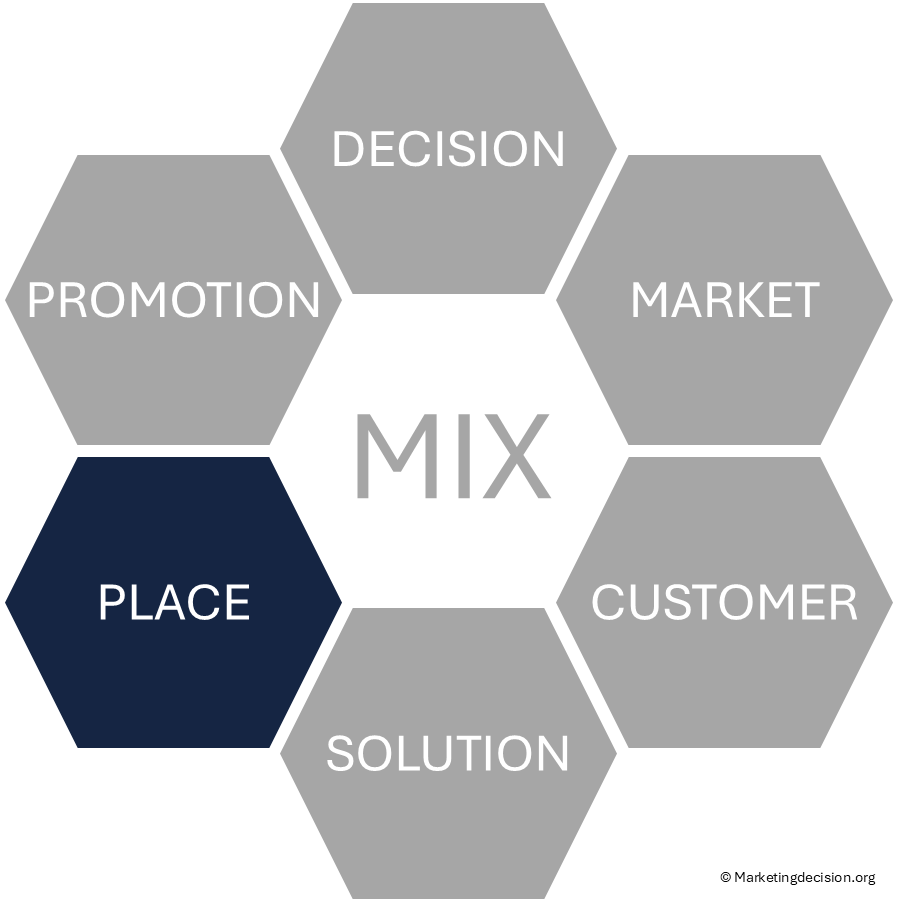

The “Place” or Distribution element in the marketing mix focuses on the strategy used to make products and solutions that meet customer needs and expectations available to the market.
Concretely, every interface with the customer contributes to “place.” This includes sales representatives, service support teams, and participants in distribution networks. The scope extends to all customer-facing roles within the company, such as influencers, CEOs, and e-commerce platforms, whose contributions have become essential in the distribution of products and solutions.The Place or Distribution element in the marketing mix is the strategy applied to make products and solutions available to the market.
There are many operational ways to address “place,” including techniques focused on the “what” and “how” of distribution: “How can we maximize training effectiveness?”, “How many salespeople should we deploy?”, and “How should we structure sales territories?” These are valid and necessary questions. However, without being anchored in the company’s strategic intent—the “why”—such techniques risk being misaligned and ineffective.
The “why” questions act as a compass for optimizing place strategy. When facing ambiguity or challenges in implementation, returning to the core “why” helps clarify objectives, identify business priorities, and ensure alignment across marketing, sales, and distribution decisions.
A further challenge lies in the many metrics and signals used by marketing, sales, and support teams. These indicators often reflect internal performance (e.g., pipeline health or conversion ratios) but may fail to capture alignment with broader company goals. To avoid misinterpretation and poor prioritization, it is essential to define a shared and consistent set of strategic objectives to guide the go-to-market (GTM) approach.
Moreover, “place” cannot be optimized in isolation. It must reflect market dynamics, customer segments, solution value, and promotional strategy. Market and customer understanding help identify the most profitable and scalable segments, while product and promotional strategies determine how these segments can be effectively targeted.
For these various reasons, it’s crucial to continually ask key strategic questions such as:

These questions, targeted toward understanding the “Why,” are essential to strategic placement. This underscores the importance of consistently referring back to company priorities and needs in all actions related to optimizing placement, such as those described below.
Multiple chapters are developed to detail and cover the following challenges that are part of the company strategy to maximize place efficacy and capitalize on every emerging market opportunity as early and efficiently as possible.
Understanding the strengths and weaknesses of a sales organization requires examining several aspects of the go-to-market strategy.

The goal extends beyond merely identifying pain points to assessing how well the sales organization meets business needs and aligns with the company priorities—the “why.”
When developing a marketing plan, factors such as market trends, customer needs and expectations, and product offerings must be considered, shaping the go-to-market approach. Developing an updated strategy involves aligning strengths and weaknesses with business priorities and market needs.
Benchmarking or assessing your go-to-market approach can focus on six core components: Channels, Sales Headcount, Territory Design, Skills and Competencies, Sales Targets, and Sales Enablement.
The objective of this assessment is to:

This assessment offers an opportunity to consider the competition and their organization. For those exploring alternative distribution channels, there is much to learn about place options by examining market dynamics and competition.

Multiple channels can be considered—whether direct or indirect, e-commerce, or via dealers and distributors—either individually or in combination, depending on needs. Each channel offers different advantages and disadvantages in terms of cost, flexibility, and capability to address all targeted customer segments.
Benchmarking the current go-to-market model involves questioning the current approach and considering potential future models. What benefits would they bring? How would they address your critical needs and priorities?
Benchmarking is an essential first step before all other efforts to optimize sales operations, grow revenue, and enhance profitability.

Whether direct or indirect, adding a salesperson is both a risk and an opportunity. Salespeople are not easily interchangeable, even if some companies attempt regular territory changes, sometimes even weekly.
Salesperson performance limitations result not only from skills and competencies but also from workload. There are a finite number of working hours in a day, and, for instance, excessive travel leads to lost opportunities for customer engagement and sales discussions.
Increasing sales headcount can help reduce territory size and increase overall team capacity. However, this expansion comes at a cost. Thus, developing tools to free up time for salespeople is essential, which is why effective CRM solutions are critical for team productivity and efficiency.

Ensuring sales territories are appropriately sized is a continuous challenge. Issues such as new business opportunities and employee absences must be managed alongside the need for efficient territory coverage.
In a perfect world, all territories would be the same size in terms of potential, complexity, and history:
In our real world, these metrics, measured at local levels and for each sales territory, provide the capability to assess and compare sales territories. Sales territories can be optimized. Additionally, this provides an opportunity to establish local metrics and monitor presence and growth in market segments.
Unbalanced sales territories—with some salespeople handling large territories and easier-to-prospect customers, while others struggle to achieve volumes in smaller and competitive areas—may lead to significant inefficiencies. Correcting territory and workload misalignment may be more important than changing the headcount volume.
Developing sales competencies is key to successful teams.
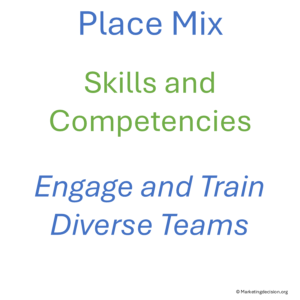
This usually begins with sales meetings where experienced salespeople share successful strategies against competitors and elaborate on future sales tactics. This extends to marketing and sales gatherings where solution features and positioning are reviewed and continues through training sessions covering techniques, legal aspects, finance, and more.
“Learning from Mistakes is Expensive”
Without adequate training, salespeople may rely on trial and error, potentially leading to missed opportunities. Identifying training needs early is crucial to increasing win rates and profitability. While assessing the financial impact of training can be challenging, analyzing past wins and losses can reveal where deals were lost due to insufficient product knowledge, ineffective messaging, incorrect product positioning, inappropriate pricing strategies, failure to identify key decision-makers and influencers, etc. These lost deals can add up to significant revenue and profitability, underscoring the importance of training.

Managing and setting sales targets is an essential process for a successful sales team. There are multiple approaches to setting targets. When sales incentives are not appropriate, salespeople may leave and join your competition. Hiring and developing competencies is usually a lengthy process, often taking several months. Retaining a sales team is key.
Indeed, unbalanced territories and poorly set targets can have critical impacts:
Hence, sales territories must be well-designed with targets adjusted to local conditions.

Sales enablement involves equipping sales teams and the entire organization to effectively address the market, identify opportunities, and close deals. This requires implementing tools and mechanisms to streamline operations. CRM systems, sales mechanisms, shipment processes, and back-office operations are critical parts of the sales ecosystem. These elements boost organizational efficiency.
By measuring sales performance, the entire ecosystem’s efforts are assessed. Revenue and profitability result from the combined work of front and back offices. The variety of tools used in this process demonstrates their value in enhancing performance and achieving success.
In the marketing mix, Place is where expectations on sales management are especially high. Managing sales challenges, motivating and leading a sales team, and maintaining a proper balance between Back Office and Front Office functions are essential. This is where marketing professionals involved in the Place mix can most effectively support company strategies and recommend actions to sales managers.
There are numerous opportunities for effective sales placement, making it crucial to regularly assess the go-to-market strategy to identify gaps and opportunities. Key questions often arise around salesforce deployment (whether direct or indirect), skills and competencies, team collaboration in alignment with company objectives, and sufficient Back Office support. This multifaceted Place challenge requires a systematic approach.
Ultimately, it is the skills of sales managers that address the human challenges of leading a salesforce. However, balancing the complexity of sales territories and the volume of opportunities requires support from dedicated experts in marketing or sales operations, ensuring that all sales personnel are on an equal footing with fair targets. Finally, creating a consistent “one face to the customer” that embodies the company vision is one of the most valuable contributions that the Place mix brings to business health.
Your feedback and specific needs are greatly valued. Feel free to reach out to us at contact@marketingdecision.org if you have any questions, special requirements, or recommendations.
© marketingdecision.org
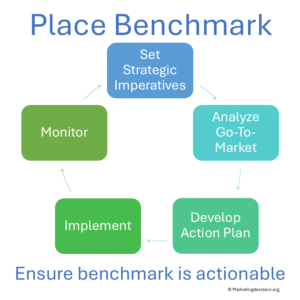 Benchmarking the Go-To-Market approach can act as a revealer for needed adjustments or significant transformations required or recommended by a management team. Through a synthetic approach, attention can be brought to the “why” of transformation, helping clarify the needs before discussing execution plans.
Benchmarking the Go-To-Market approach can act as a revealer for needed adjustments or significant transformations required or recommended by a management team. Through a synthetic approach, attention can be brought to the “why” of transformation, helping clarify the needs before discussing execution plans.
A sales benchmark is indeed essential for evaluating the current Go-To-Market before considering evolutions to your sales organization. It provides a synthetic and clear view of the status before any transformation. When transformation is implemented, a comparison can be made between targeted and achieved results, providing key information on the success of the transformation. Additionally, hypotheses retained during consideration of the transformation initiative can be analyzed retrospectively, with key learning points useful for future transformations.
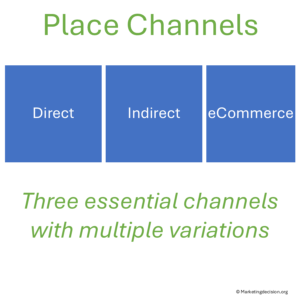 Selecting a channel organization is a key decision with long-term impact. Multiple channels can be considered, direct or indirect, ecommerce, or via dealers and distributors, either one at a time or simultaneously. Each brings different advantages and disadvantages in terms of cost, flexibility, and capability to address all customer segments. It must be wisely addressed, and when possible, new channel solutions should be tested and evaluated before full deployment.
Selecting a channel organization is a key decision with long-term impact. Multiple channels can be considered, direct or indirect, ecommerce, or via dealers and distributors, either one at a time or simultaneously. Each brings different advantages and disadvantages in terms of cost, flexibility, and capability to address all customer segments. It must be wisely addressed, and when possible, new channel solutions should be tested and evaluated before full deployment.
Channel initiatives must start with a benchmark to evaluate the current organization and consider the advantages and disadvantages of a channel organization change. Some strategies may pose serious disadvantages, for instance, when losing control over the customer base and must be evaluated with much attention, such as agents who act as independent sales individuals and in many countries own rights to their customer base.
 Optimizing headcount is crucial for sales organizations. Determining the number of salespersons in a direct or indirect organization is a crucial question. Discussions between two opposing models—a large organization with multiple heads capable of penetrating every segment to increase market share and presence, and smaller ones focusing on more profitable business segments and being more flexible to address changing market situations—are very beneficial.
Optimizing headcount is crucial for sales organizations. Determining the number of salespersons in a direct or indirect organization is a crucial question. Discussions between two opposing models—a large organization with multiple heads capable of penetrating every segment to increase market share and presence, and smaller ones focusing on more profitable business segments and being more flexible to address changing market situations—are very beneficial.
A thorough analysis of the sales territory, market conditions, and sales objectives is required to determine the optimal number of salespeople needed. This analysis can include a comprehensive evaluation of the sales organization’s capacity and the potential impact of adding, removing, or maintaining salespeople. By understanding the trade-offs, sales organizations can make informed decisions that balance sales costs with sales volume potential, market penetration, and profitability.
 Balancing sales territories across a sales team can be complex. Ensuring sales individuals are aligned to market opportunities with a fair balance of potential and complexity, taking into account past history of territory performance and sales capacity is the topic of this chapter.
Balancing sales territories across a sales team can be complex. Ensuring sales individuals are aligned to market opportunities with a fair balance of potential and complexity, taking into account past history of territory performance and sales capacity is the topic of this chapter.
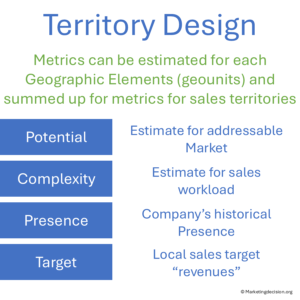 Fortunately there are methods to design sales territories ensuring they are appropriately sized and structured so that salespersons get a fair share of the market. With those methods it becomes easier to set sales targets across sales persons with varying levels of expertise and experience.
Fortunately there are methods to design sales territories ensuring they are appropriately sized and structured so that salespersons get a fair share of the market. With those methods it becomes easier to set sales targets across sales persons with varying levels of expertise and experience.
The development of local metrics required for sales territory design, bring significant additional advantages, the most obvious being to allow the calculation of estimates for local market share and local visibility. through understanding deals won by you and your competition, using an appropriate CRM system, the local market share can be estimated providing a key marketing information.
Understanding which sales territories are too large and which are too small is absolutely essential. This is where you learn where money is left on the table, and why some sales persons miss their sales targets and leave for competition.
 Enhancing the strengths of a sales organization is vital. It begins with sales meetings where experienced sales professionals share successful sales encounters against competitors and elaborate on sales tactics and strategies. This learning process extends to marketing and sales gatherings where product features and positioning are deliberated upon, and it further evolves through various sales training sessions covering topics such as sales techniques, legal aspects, finance, and more.
Enhancing the strengths of a sales organization is vital. It begins with sales meetings where experienced sales professionals share successful sales encounters against competitors and elaborate on sales tactics and strategies. This learning process extends to marketing and sales gatherings where product features and positioning are deliberated upon, and it further evolves through various sales training sessions covering topics such as sales techniques, legal aspects, finance, and more.
 Without adequate sales training, salespersons may resort to trial and error with sales tactics, potentially leading to missed opportunities. Identifying training needs early is crucial to increasing wins and improving profitability. While it can be challenging to assess the financial impact of training, analyzing past win and loss data may reveal instances where deals were lost due to factors such as insufficient product knowledge, ineffective messaging on product features, incorrect product positioning, inappropriate pricing strategies, failure to identify key decision-makers and influencers, etc. The cumulative impact of these lost deals likely represents a significant portion of total revenue and profitability, underscoring the importance of training.
Without adequate sales training, salespersons may resort to trial and error with sales tactics, potentially leading to missed opportunities. Identifying training needs early is crucial to increasing wins and improving profitability. While it can be challenging to assess the financial impact of training, analyzing past win and loss data may reveal instances where deals were lost due to factors such as insufficient product knowledge, ineffective messaging on product features, incorrect product positioning, inappropriate pricing strategies, failure to identify key decision-makers and influencers, etc. The cumulative impact of these lost deals likely represents a significant portion of total revenue and profitability, underscoring the importance of training.
 Sales plans with bonuses and accelerators when objectives are met or exceeded are classics for sales teams. Company results are delivered through the work of sales individuals, and many companies have adopted variable compensation plans to motivate and engage sales teams.
Sales plans with bonuses and accelerators when objectives are met or exceeded are classics for sales teams. Company results are delivered through the work of sales individuals, and many companies have adopted variable compensation plans to motivate and engage sales teams.
 There are multiple approaches to handling sales targets, and they can be complex to put in place and manage over time. For a direct organization with a fixed number of salespersons, a variable sales compensation allows for reducing the total sales compensation when the market is down. Sales compensation becomes an adjustable variable for market fluctuations. On the other hand, when the market is up, sales programs with accelerator incentives allow for targeting higher volumes.
There are multiple approaches to handling sales targets, and they can be complex to put in place and manage over time. For a direct organization with a fixed number of salespersons, a variable sales compensation allows for reducing the total sales compensation when the market is down. Sales compensation becomes an adjustable variable for market fluctuations. On the other hand, when the market is up, sales programs with accelerator incentives allow for targeting higher volumes.
 Sales enablement involves engaging sales teams and the entire organization to address the market, identify opportunities, and close deals. It requires implementing numerous tools and operational mechanisms to streamline business activities. CRM systems, sales operating mechanisms, shipment, installation, and all back-office operations that are part of the sales ecosystem must be established and activated. These elements are what make your sales organization efficient.
Sales enablement involves engaging sales teams and the entire organization to address the market, identify opportunities, and close deals. It requires implementing numerous tools and operational mechanisms to streamline business activities. CRM systems, sales operating mechanisms, shipment, installation, and all back-office operations that are part of the sales ecosystem must be established and activated. These elements are what make your sales organization efficient.
Sales enablement is company enablement. Sales is the visible part of your company organization to customers. A healthy organization, where sales are successful, is an organization where all functions are successful.

This website focuses on the marketing mix and its key decision areas. Each category includes links to detailed methods, with some offering related tools available for purchase in our webshop. For easy navigation, use the main menu in the header to explore the marketing mix framework and methods. To go directly to the webshop, select the Shop menu in the header or click the link below. You can also browse by category.
© 2025 MARKETING DECISION SOLUTIONS. All Rights Reserved.